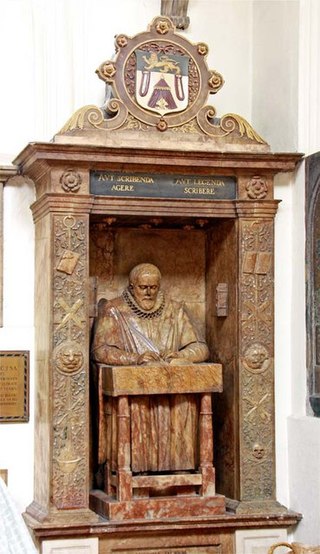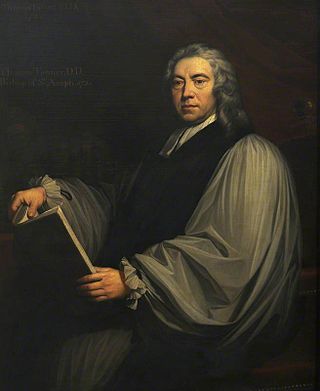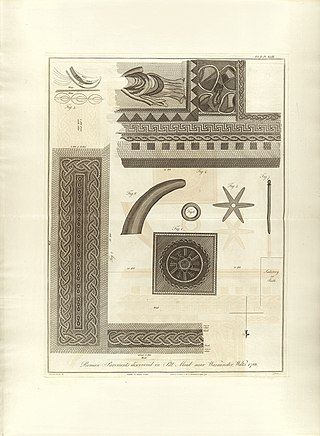
An antiquarian or antiquary is an aficionado or student of antiquities or things of the past. More specifically, the term is used for those who study history with particular attention to ancient artifacts, archaeological and historic sites, or historic archives and manuscripts. The essence of antiquarianism is a focus on the empirical evidence of the past, and is perhaps best encapsulated in the motto adopted by the 18th-century antiquary Sir Richard Colt Hoare, "We speak from facts, not theory."

John Nichols was an English printer, author and antiquary. He is remembered as an influential editor of the Gentleman's Magazine for nearly 40 years; author of a monumental county history of Leicestershire; author of two compendia of biographical material relating to his literary contemporaries; and as one of the agents behind the first complete publication of Domesday Book in 1783.

John Stow was an English historian and antiquarian. He wrote a series of chronicles of English history, published from 1565 onwards under such titles as The Summarie of Englyshe Chronicles, The Chronicles of England, and The Annales of England; and also A Survey of London. A. L. Rowse has described him as "one of the best historians of that age; indefatigable in the trouble he took, thorough and conscientious, accurate – above all things devoted to truth".

Richard Rawlinson FRS was an English clergyman and antiquarian collector of books and manuscripts, which he bequeathed to the Bodleian Library, Oxford.

Thomas Tanner was an English antiquary and prelate. He was Bishop of St Asaph from 1732 to 1735.

The Society of Antiquaries of London (SAL) is a learned society of historians and archaeologists in the United Kingdom. It was founded in 1707, received its royal charter in 1751 and is a registered charity. It is based at Burlington House in Piccadilly, a building owned by the UK government.

A monumental brass is a type of engraved sepulchral memorial once found through Western Europe, which in the 13th century began to partially take the place of three-dimensional monuments and effigies carved in stone or wood. Made of hard latten or sheet brass, let into the pavement, and thus forming no obstruction in the space required for the services of the church, they speedily came into general use, and continued to be a favourite style of sepulchral memorial for three centuries.
In archaeology, a typology is the result of the classification of things according to their physical characteristics. The products of the classification, i.e. the classes, are also called types. Most archaeological typologies organize portable artifacts into types, but typologies of larger structures, including buildings, field monuments, fortifications or roads, are equally possible. A typology helps to manage a large mass of archaeological data. According to Doran and Hodson, "this superficially straightforward task has proved one of the most time consuming and contentious aspects of archaeological research".

John Bagford was an English antiquarian, writer, bibliographer, ballad-collector, bookseller, and biblioclast.

Thomas Astle FRS FRSE FSA was an English antiquary and palaeographer. He became a fellow of the Society of Antiquaries and the Royal Society.

Charles Lyttelton (1714–1768) was an English churchman and antiquary from the Lyttelton family, who served as Bishop of Carlisle from 1762 to 1768 and President of the Society of Antiquaries of London from 1765 to 1768.
Roger Gale was an English scholar and antiquary as well as a Whig politician who sat in the English and British House of Commons from 1705 to 1713. His father was an ecclesiastic and professor at Cambridge, which the younger Gale also attended. After his graduation, Gale briefly served as a diplomat in France, as well as holding a position as a reader at Oxford University's Bodleian Library. On his father's death in 1702, Gale retired to his family estate, but was elected to Parliament in 1705, where he served until 1713. He then continued in public service until 1735, when he once more retired to his estates.
Jacob Schnebbelie was an English draughtsman, specialising in monuments and other historical subjects.
George Ashby (1724–1808) was an English antiquary and sometime president of St John's College, Cambridge.
Michael Tyson was an English Anglican priest, academic, antiquary, and artist.
George North (1707–1772) was an English cleric and numismatist.
Craven Ord (1756–1832) was an English antiquarian. He was particularly noted for his brass rubbings.

Foote Gower (1725/6–1780) was an English cleric, academic and antiquarian.

The monumental brass of John Rudying is a brass of 1481 to Archdeacon John Rudying in the Church of St Andrew in Biggleswade in Bedfordshire noted for the surviving Figure of Death. The monument was rediscovered under the chancel floor in 1955 during restoration and has been described as "very remarkable" by English Heritage.

Catherine Downes was an English antiquarian and archaeologist, who excavated a Roman villa near Warminster, Wiltshire, in 1786. Downes is a significant figure in the early history of archaeology, since she was one of the first women antiquarians to excavate a Roman site; the other was Frances Stackhouse Acton. Downes is also one of the earliest recorded women who contributed to the work of the Society of Antiquaries of London.












